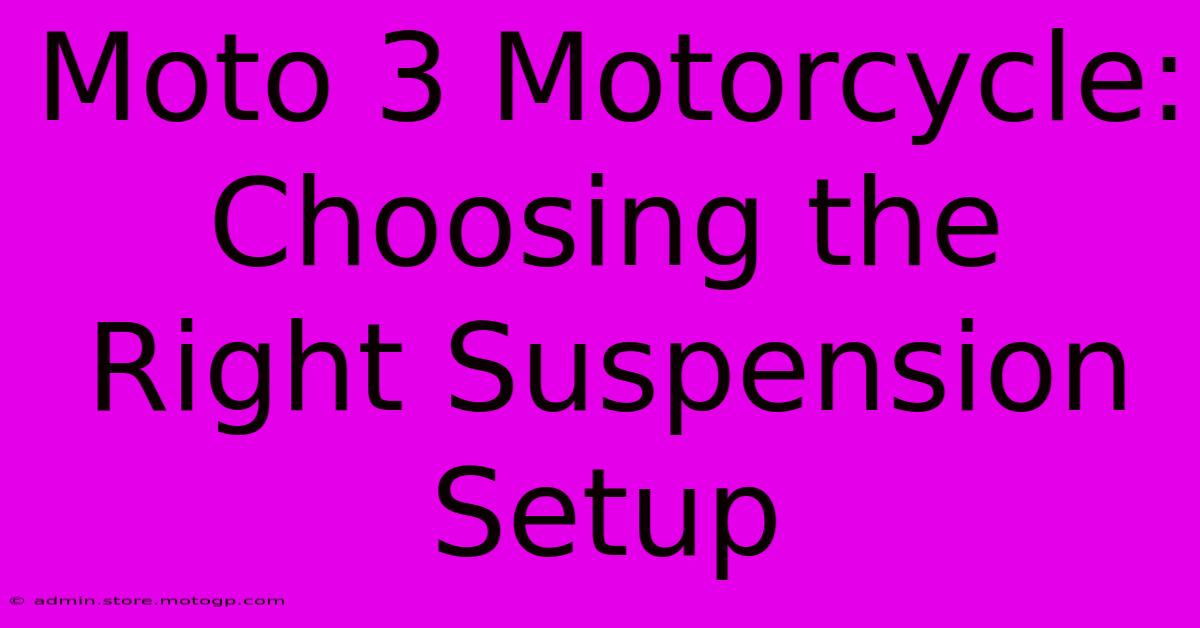Moto 3 Motorcycle: Choosing The Right Suspension Setup

Table of Contents
Moto 3 Motorcycle: Choosing the Right Suspension Setup
The Moto3 class is all about razor-sharp handling and lightning-fast reflexes. A significant factor in achieving this competitive edge lies in the precise tuning of your motorcycle's suspension. Getting your suspension setup right can mean the difference between podium finishes and frustrating DNFs. This guide will delve into the nuances of Moto3 suspension, helping you optimize your bike for maximum performance.
Understanding Moto3 Suspension Components
Before diving into setup, let's understand the key components:
Front Forks:
Moto3 bikes typically utilize inverted telescopic forks. These forks are crucial for controlling front-end grip and responsiveness. Key adjustments include:
- Spring Preload: This alters the initial ride height and affects the responsiveness of the fork. More preload increases ride height and stiffness.
- Compression Damping: Controls how quickly the fork rebounds after compression. Increased compression damping slows the rebound, offering more stability under braking and corner entry.
- Rebound Damping: Regulates the speed at which the fork extends after compression. Faster rebound can lead to a choppy ride, while slower rebound can result in excessive dive under braking.
Rear Shock:
The rear shock absorber is equally critical for handling and stability. Adjustments include:
- Spring Preload: Similar to the front, this affects the ride height and overall stiffness.
- High-Speed Compression Damping: This setting influences the shock's response to large bumps and impacts.
- Low-Speed Compression Damping: Affects the shock's response to smaller bumps and changes in terrain.
- Rebound Damping: Controls how quickly the shock extends after compression, influencing stability on corner exit and overall traction.
Factors Influencing Suspension Setup
Several factors necessitate careful consideration when tuning your Moto3 suspension:
- Rider Weight and Style: A heavier rider will require stiffer spring rates compared to a lighter rider. Riding style – aggressive versus smooth – also influences the optimal damping settings.
- Track Conditions: Smooth tracks require different settings than bumpy or abrasive circuits. Adjustments to damping are crucial to maintain stability and grip across varying track surfaces.
- Tire Pressure and Condition: Tire pressure significantly impacts how the suspension interacts with the track. Low tire pressure might necessitate softer suspension settings, while higher pressure demands stiffer settings. Tire wear also influences the desired suspension setup.
- Aerodynamics: At Moto3 speeds, aerodynamic forces play a noticeable role. The suspension setup needs to account for these forces to maintain stability and prevent unwanted movement.
Step-by-Step Suspension Tuning Guide
Optimizing your Moto3 suspension is an iterative process. Here's a structured approach:
- Baseline Setup: Start with the manufacturer's recommended settings as a baseline.
- Spring Rate Selection: This is crucial. Choose spring rates appropriate for the rider's weight and riding style. Professional suspension tuners can assist in selecting the correct spring rate.
- Sag Setting: Set the static and race sag according to the manufacturer's specifications. Proper sag ensures optimal suspension travel and responsiveness.
- Compression Damping Adjustment: Begin by adjusting the compression damping for stability under braking and corner entry. Fine-tune this setting by monitoring the bike's reaction to bumps and braking forces.
- Rebound Damping Adjustment: Adjust the rebound damping to control the suspension's extension speed. Pay close attention to the bike's behavior on corner exit and under acceleration.
- Track Testing: Repeated track testing is critical. After each adjustment, assess the bike's handling characteristics and make further modifications based on your observations.
- Data Logging: Using data loggers can provide valuable insights into suspension performance. Analyze the data to identify areas for further optimization.
Seeking Professional Assistance
Fine-tuning a Moto3 motorcycle's suspension is a complex undertaking. Consider seeking guidance from experienced suspension technicians or engineers. Their expertise can significantly accelerate the optimization process and ensure you extract maximum performance from your machine.
Keywords: Moto3, motorcycle suspension, suspension setup, Moto3 suspension tuning, motorcycle tuning, racing motorcycle, suspension adjustment, spring preload, compression damping, rebound damping, race setup, track conditions, rider weight, tire pressure, professional suspension tuning.

Thank you for visiting our website wich cover about Moto 3 Motorcycle: Choosing The Right Suspension Setup. We hope the information provided has been useful to you. Feel free to contact us if you have any questions or need further assistance. See you next time and dont miss to bookmark.
Featured Posts
-
The Definitive Moto Gp Experience Tnt Sports
Feb 17, 2025
-
Moto Gps Most Influential Riders Shaping The Sport
Feb 17, 2025
-
F1 Austin Tv Schedule Stay Ahead Of The Curve
Feb 17, 2025
-
Moto Gps Most Memorable Moments Celebrating The Champions
Feb 17, 2025
-
Cota F1 Merchandise Perfect Gifts For F1 Fans
Feb 17, 2025
